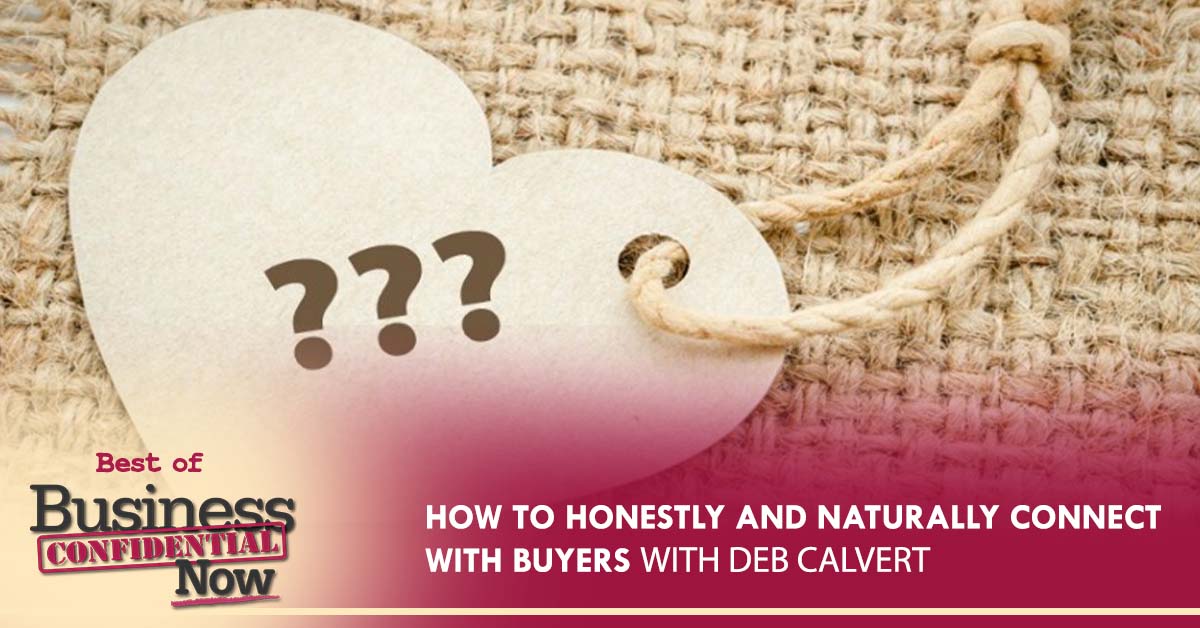
Photo Credit: © Can Stock Photo / Gamjai
Want to know how to REALLY connect with buyers and thrive in today’s marketplace? Join host Hanna Hasl-Kelchner as she welcomes sales expert and author Deb Calvert, who says, “stop selling.” Is that crazy or what?
WHAT YOU’LL DISCOVER ABOUT HOW TO CONNECTING WITH BUYERS
- 3 powerful ways to build trust and connecting with buyers.
- How to find out what really matters to buyers.
- How asking salient questions creates customer value.
- What you should be asking prospects but probably don’t.
- Why natural conversations are more effective way to connect with buyers than pitching.
- And MUCH more.
GUEST
 Deb Calvert helps companies boost productivity and build organizational strength by helping you put people first.
Deb Calvert helps companies boost productivity and build organizational strength by helping you put people first.
She accomplishes this in a number of ways, through:
-
-
-
-
- sales training, coaching, and consulting;
- leadership programs;
- strategic planning with senior managers; and
- other team effectiveness work and executive coaching with business owners and senior managers.
-
-
-
She’s the founder and President of People First Productivity Solutions, a three-time Top 50 Sales and Marketing Influencer, and bestselling author of the book DISCOVER Questions® Get You Connected as well as an award-winning blogger.
Deb is also a member of the National Speakers Association and as a speaker has delighted audiences in a wide variety of industries. She is now leading the movement to “Stop Selling and Start Leading!”
RELATED RESOURCES
Contact Deb and connect with her on LinkedIn and Facebook.
Get your free chapter from Deb’s book Discover Questions Get You Connected.
—
How To Honestly And Naturally Connect With Buyers With Deb Calvert
Do you want to know how to connect with buyers and have your business thrive in nowaday’s economy? Our guest sales expert, Deb Calvert, says stop selling. Is that crazy or what? We will find out what she is talking about.
—
Deb Calvert helps companies boost productivity and builds organizational strength by helping you put people first. How does she do that? She does it in a number of ways through sales training, coaching, consulting, leadership programs, strategic planning with senior managers, and other team effectiveness work and executive coaching with business owners and senior managers.
She is the Founder and President of People First Productivity Solutions. She is also a three-time Top 50 Sales and Marketing Influencer and has a best-selling book called DISCOVER QUESTIONS GET YOU CONNECTED. She is also an award-winning blogger. As a member of the National Speakers Association, she did a lot of speaking and delighted audiences in a variety of industries. She is now leading a movement called Stop Selling and Start Leading. I am certainly looking forward to knowing more about that one.
—
Welcome to the show, Deb.
Hanna, thank you so much for inviting me to be on the show. I am thrilled to be a part of your show. I love what you are doing there.
Thank you. We are excited to have you. This movement, Stop Selling and Start Leading, sounds intriguing. Tell me more about that.
It is a movement. It is more than an idea and it has been taking shape. It is about behavior change. It is about a progression or a change of position. It is the opposite of inertia because business owners, entrepreneurs, and sellers can get stuck. If they could stop selling and start leading, they would find that they are unstuck and that buyers are following them.
How do they lead? What does this mean for small to mid-size companies, entrepreneurs, and people who want to take their business to the next level?
I work with a number of small businesses and entrepreneurs who attached this icky factor to the part of their business that is selling. Even people who are sales professionals sometimes can have a disdain for those stereotypical sales behaviors. Yet, I have seen it happen with even the very best of sellers and the smartest of business owners, and those stereotypical behaviors sometimes emerge when it comes time to sell.
When they do, buyers draw away and even the seller or business owner finds themselves pulling back. They know those behaviors are off-putting so they can step into their roles as leaders and begin to lead buyers instead of selling to them. We know because we are looking at research. That is how you get results and it is also how you feel better about those interactions with your buyers.
Nobody likes the pushy car salesman stereotype. No offense to car salespeople out there because we all drive cars and we all love him, so we need you. The reality is nobody likes that pushiness. You are right. Immediately your guard goes up. You understand what is going on. How do you lead? Tell me what you mean by that. That sounds good, but how does a work?
Here is how it all came together. I work in these two spaces. I work in sales and leadership. I have done that for decades. It occurred to me one day as I was going through and conducting a leadership training program. I used the leadership challenge, which is the evidence-based foundation of about everything out there related to leadership. Jim Kouzes and Barry Posner spent many years researching the behaviors of leaders. They know that there are 30 behaviors of exemplary leaders. When they demonstrate those 30 behaviors, people more willingly follow them.
Step into the role of leaders and begin to lead buyers instead of selling to them. Share on XWe are talking about behaviors that are enabling, inspiring, and encouraging to others which were my a-ha. What if sellers adopted those behaviors? What we are now finding from our research with buyers is that when buyers view sellers differently and when sellers are exhibiting leadership behaviors, it changes the entire relationship.
We know that we want to be able to enable, inspire, and encourage the people we want to do business with because we have got goods and services that can help them. That is the whole purpose of business. How do we do that?
It is very concrete and specific ways. Let’s start with inspire. Instead of pitching products, being pushy, or trying to talk someone into it, when you are inspiring, the behaviors of inspiring include things like this and letting others know how their own self-interest can be realized by entering into a vision that you have painted for them. Another behavior that you painted a vision for them. You showed them, told them, and described to them what that future could be like. When you are doing that and creating a vision, sharing it, and bringing others into it, those behaviors are very much more likely to mobilize people into action.
Enable is an interesting one because we do not typically think of enabling our buyers. We think about doing everything we can for them, which is exactly contrary to enabling them. There is a piece of research that does a good job of encapsulating this. It is from a book called The Future of Competition, and the authors write about the bottom-up economy that we are now in. They conclude that consumers will migrate to businesses that allow them to be participants in the process of creating what they want.
Let’s put this back into the B2C space so everybody can relate to it. Enabling would be like what Chipotle does for Build-A-Bear Workshop or Sephora makeup. You go to those stores and you participate in creating what you want. You are enabled to make choices and decisions along the way through the process. You are given some opportunity to collaborate with the people who are selling something to you as opposed to it being one direction. That is what that one is all about.
It is more customization that they get to pick as opposed to one size fits all.
Absolutely. Even if you sell a single good or service to be able to enable your buyer and give them an opportunity to shape something about the experience. Whether it is the delivery or frequency, there is something there that if you can ask questions, draw them out, and get them participating in creating what they want and how they want it, that is where they are being connected with you. That is where they feel like you are different from all of your competitors.
These asking questions, does this connect with your book, DISCOVER Questions Get You Connected?
It does, although the book came before all of this research. It is interesting that there ends up being a connection. DISCOVER is an acronym. The word DISCOVER in DISCOVER Questions Get You Connected, each of those letters stands for a different purpose for asking questions. There are eight purposes for asking questions. When someone understands how to diversify the choices they are making and the purpose or reason they are asking the question, they can get a lot more information. Being a very good question asker certainly sets you up for success when it comes to doing things like enabling your buyers.

Connecting With Buyers: When someone understands how to diversify the choices they’re making, and the purpose or reason they’re asking the question, they can get a lot more information.
This sounds a little abstract to me. Can you give me an example?
Let’s say that you are using the V question in DISCOVER. In that acronym, the letter V is for Value. It is a question that does not often get asked, but it is so important to understand what your buyer truly values and the hierarchy of how they value those things. Let’s say that you are working with a buyer and the first need that they express is the one that you pounce on. If you have a solution, you meet that need and it is a very transactional and quick exchange.
It is very different from if you ask them, “Why is this important to you? How important is this to you? What else is important to you? Tell me about your needs and rank them for me, 1, 2, 3.” You get this much bigger picture around what matters to that buyer. Having done that, you can respond to the primary need. You can respond to a secondary one. You can create a connection again with that buyer because you are different. You are asking these questions that involve them. You are giving them a chance to be challenged and think through what they want. It does not take much time to create this bond that will lead to customer loyalty.
Let me give you another piece of research because this helps to bring together what we are talking about. Dr. David Lewis is at Mindlab International. He is talking about modern buyers. He says that shopping experiences trigger brain activity that creates euphoric moments. We call that retail therapy, but what he says is these euphoric moments can be triggered by experiencing something unexpected.
Threading all of the pieces here together, we create an experience with buyers by asking questions. Those questions alone create value. The buyer is experiencing something unexpected. They are participating in creating what they want as you ask these questions and involving and enabling them. They are beginning to trust you and see you as different from all of your competitors and want to continue to work with you and you alone because of this connecting experience that you are pulling together for them. Does that help make it less abstract?
It helps make it less abstract, but there is a basic assumption that you are making that this prospect or customer wants to be sold to. I am going to challenge that a little bit because a lot of people put their guard up very quickly and they do not necessarily want to give you a whole lot of information because “Now come the emails. I am going to sit here and have to listen to it.” You get those cold calls where somebody immediately starts talking the minute the phone is answered, and you can’t get a word in edgewise. They are reading from a script. We have all been through that.
Do you want to connect? I do not know if I want to connect. I am going to be a little bit more circumspect in the information that I am giving you because if I tell you my biggest pain point, you are going to try to sell me something for that. I am not necessarily convinced that you have got the right solution because we have been wired to think, “They want to sell me something.” I get the feeling there is a little preliminary work that needs to be done in order to make sure you are talking to somebody who is ready, willing, and able to buy if you have the right solution for them.
Agreed. I mentioned value. Those questions came later in a conversation once some may have been expressed. If we go back to the beginning, when we are initially trying to connect with someone, the approach is much the same. You have got to differentiate yourself and give a buyer an opportunity to see that you are different from all those other sellers who are doing those selling behaviors that we do not only put our guard up but adamantly resist.
In fact, buyers will go to great lengths not to be sold to, but buyers will also go to great lengths to have an awesome connecting experience and can go out of their way to come to you if you show this to them. Those words are from Michael Doran in the Wall Street Journal. To be able to create this awesome connecting experience early on, we should not use a script. We should not be pitching over the phone and putting products front and center.
It's so important to understand what your buyer truly values and the hierarchy of how they value those things. Share on XA modern buyer is so empowered and does not want any of that to be going on. We need to be able to know a little bit about them if we are cold calling, and these are outbound calls, to connect around that information and ask salient questions that are going to demonstrate right off the bat that we create value in our conversations alone. It is about setting your intent internally, knowing your intent is to help. Expressing your intent and demonstrating your difference early on so that buyers will gravitate to you, open up, and give you permission to have a deeper, more meaningful conversation.
I like those concepts but I am not sure how many of our readers are involved with cold calling. That is a very specific niche of companies that do that type of thing, but I do think that all of our readers do get involved in certain types of networking experiences, whether they belong to trade associations or they go to conferences and meetings. There are people to meet outside the immediate organization that may or may not be able to refer business to them.
It is a softer selling approach where these kinds of concepts could apply because it is having that conversation. It is building a rapport or maybe creating a friend or colleague. If you are at a networking function, a meeting, or a conference, what would be some good opening questions? What would you recommend?
The same question comes up over and over again, and it is because we are all having the common experience of being at the conference. That question when you meet someone new is usually something around the lines of, “What brings you here? What do you do?” Those are great questions. The unfortunate thing is what happens next. That is where people all too often are either looking over your shoulder because they realize that you are probably not a prospect for them or they think you may be a prospect and they start pitching.
It is wholly inappropriate. That is not why we are here. We are here to make the connection. It is a networking event. It is all about connections. Sell some other time. Do not sell here and now. The next questions are, “How are you? What are you doing? What brings you here?” Now, you need to use some other questions. “Tell me more about your business,” because even if it is not a prospect for you, chances are there is something within that business that is going to get you connected to somewhere else or it is a question about, “What are the kinds of things that you are looking for at this conference?”
Having that dialogue and being able to more naturally get to know someone can lead to other connections and referrals. Instead of trying to go around the room, meet as many people as possible, and collect business cards, have richer conversations. Connections lead to referrals, even if it is not a primary prospect for you.
Why do you think more people do not do that?
Adrenaline is partly to blame. We think we are supposed to sell something. We do not like the fact that we are supposed to sell something. We are hyper-charged up anyway in this sea of people. We lose sight of backing up, being more natural, comfortable, and human-to-human. It is adrenaline and a false sense of the wrong purpose. It is the environment and that everybody else seems to be doing something frenetic week. We think we should, too.
In terms of people having a short attention span and very limited time, once you have identified a prospect, you know that they have a need and they have expressed it. You have gone through some of the early filterings if you will. What are the 2 or 3 most important questions that should be asked that often aren’t and can derail the selling process?

Connecting With Buyers: Having that dialogue and being able to more naturally get to know someone can lead to other connections or referrals.
I am a big believer in asking questions that help a buyer understand their own need and get committed to their own need. Back to that acronym of DISCOVER, here is one that no one ever asks. It is the E that stands for Example. I want someone to relive the experience of something that works for them and something that does not or something they imagined would work better, so I asked for an example.
That example, no matter what your business might be, something like, “Tell me about a time when this worked and when it did not work. Tell me about how you imagine this auto work as compared to how it works right now.” As people are doing this, it is essentially the very same thing. You mentioned car dealers. It is getting behind the wheel of that car to do a test drive because now you are going to have an experience. You are going to be envisioning exactly what this could be like for you. As you envision and talk about what it could be, you are selling yourself. All I have done is facilitate. I have led you by bringing openness to this bigger vision to you, giving you a chance, and enabling you to step into it.
That is incredibly powerful because it is storytelling. It is their story and they get to tell it, which is even better because through the inflections, you can identify if you are listening well, where the pain points were, what frustrated them, what words they use, and the expressions on their faces as they are telling you the story, which are all great opportunities to connect with. That is very interesting.
I love that you mentioned that because this is the magic of questions. It is not in the questions themselves. It is in the whole-hearted listening that you described. Empathetic listening for the feelings, emotions, and inflections and telling you what is most important and least important is a critical skill.
It is because we like people that care about us. That is how we are wired. Being able to respond like that is human to human as you said.
This is where true connections happen.
How did you get interested in this area? What would have been some influencers in your career that helped point you in this direction? Can you share one of them with us?
My career has three stages. Let me talk about the first stage since that is Genesis. I worked at a newspaper and it was my very first real full-time job. With my Journalism degree, I wanted to break into the newsroom, but they were not hiring people fresh out of school. My second thought was, “Any job I can get at this newspaper, the Kansas City Star, I will take it and I will work my way over to the editorial side.” My job was in classified advertising, taking incoming ads. This was back when the Sunday newspaper used to be huge with help wanted ads, so I did that.
My boss, her name is Vanessa Scrubs, saw something in me that I had not yet quite seen in myself. As I progressed through the newspaper into different jobs, a few times along the way, she reminded me, “Debbie, stay yourself. You are going to go be doing that other job, but you be yourself. Do not change anything about you.” This whole idea of authenticity has stuck with me. It was good advice going from an inside to an outside position later, an outside sales position to a sales management role. To this day, I even can hear her voice sometimes in my ear, “Debbie, be yourself,” and it matters.
Creating value in our conversations is about setting your intent internally, knowing your intent is to help. Share on XHow delightful to have had a mentor like that as opposed to someone who tried to put a square peg in a round hole or vice versa to twist you into a pretzel to conform to some business culture. That is refreshing.
She is wonderful. She was a fantastic mentor.
Are you still in touch with her?
I am. We talked via Facebook mostly. She is retired now and living the good life, but she is still an incredible supporter of mine. I love her dearly. She has made a world of difference in my life.
What a great relationship. I do have to ask you a little bit more about your book, DISCOVER Questions, Get You Connected. Was there something that happened that triggered you to sit down and write? A lot of people have ideas for books, but very few people execute and finish a book. Tell me about what it was that made you want to write that book.
People kept asking. I spent twenty years researching questions and talking to buyers, and that started with nothing more than curiosity. Over the years, as I was a sales manager and later worked with the Salesforce Advisory Board at the Kellogg School at Northwestern University, when I went into a Fortune 500 role and had 31 trainers and coaches across the country working with me, I collected questions.
When my colleagues on the Salesforce Advisory Board were field coaching and the trainers that were working with me at the 31 companies, I collected questions and started sorting them. I no longer believed that there were only three types of questions, which I came out of the school of spin selling, and that is where it starts 3 or 4 if you want to break it down into the true spin, but I knew that there were more.
I started sorting questions for myself and I identified eight purposes. I put that into a training program, took that out, and taught various audiences but people always wanted something more. They said, “You should write a book. I wish I could read a book.” The book is largely a compilation of those different scenarios that I saw in the field and of different questions that did work as well as those that did not, and some storytelling to show how it all came together.
I could talk to you about this all day because it is such a critical function of any business. If you can’t make a sale, you do not have a business but being able to connect with your customers and prospects and developing customer loyalty is an essential part of any business process. I was wondering if you had any parting thoughts for our readers.

Connecting With Buyers: You’ve got to differentiate yourself. You have to give a buyer an opportunity to see that you are different from other sellers.
Check out Stop Selling and Start Leading. It is a movement. We are doing an incredible amount of research with buyers. There is much more than we had time to talk about here. I hope you will have a chance. You can look it up. If you look up, Stop Selling and Start Leading, all the Google results are about what we are doing. We would love to hear from anybody who has more questions and anybody who would like to participate in the research. It is going full steam ahead right now.
It gives people a chance to make a difference and participate.
That is what it is all about, and I enjoy connecting with people.
Thanks so much for these tips. The examples that you gave are very powerful. There are some things that people could start using now and see how they make a difference in their results. Thank you so much for your time and for being a guest on the show.
Thank you so much, Hanna.
Important Links
- People First Productivity Solutions
- DISCOVER Questions Get You Connected
- Stop Selling and Start Leading
- The Future of Competition
- Mindlab International
- Facebook – People First Productivity Solutions
- https://info.peoplefirstps.com/download-chapter-one-of-discover-question
- http://www.LinkedIn.com/in/DebCalvertPeopleFirst
- Creating A Remarkably Sticky Marketing Message With John Jantsch – previous episode
- If you liked this interview you might also like these Sales episodes
Join, Rate and Review:
Rating and reviewing the show helps us grow our audience and allows us to bring you more of the rich information you need to succeed from our high powered guests. Leave a review at Lovethepodcast.com/BusinessConfidential
Joining the Business Confidential Now family is easy and lets you have instant access to the latest tactics, strategies and tips to make your business more successful.
Follow on your favorite podcast app here as well as on Twitter, Facebook, YouTube, and LinkedIn.
Download ♥ Follow ♥ Listen ♥ Learn ♥ Share ♥ Review ♥ Comment ♥ Enjoy
Ask Questions or Recommend a Topic/ Guest:
- Use our convenient Get in Touch form
- OR e-mail feedback(at)BusinessConfidentialRadio.com
Disclosure:
This post may contain links to products to products on Amazon.com with which I have an affiliate relationship. I may receive commissions or bonuses from your actions on such links, AT NO ADDITIONAL COST TO YOU.
